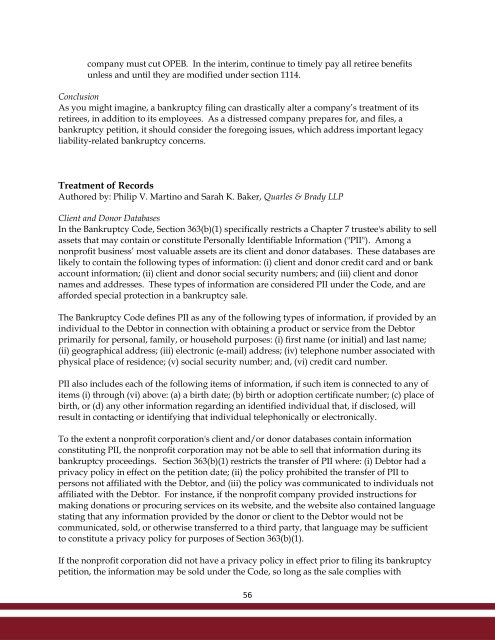Guide-for-Nonprofit-Organizations-Bankruptcy-Issues-FINAL-with-ads
Guide-for-Nonprofit-Organizations-Bankruptcy-Issues-FINAL-with-ads
Guide-for-Nonprofit-Organizations-Bankruptcy-Issues-FINAL-with-ads
- No tags were found...
Create successful ePaper yourself
Turn your PDF publications into a flip-book with our unique Google optimized e-Paper software.
company must cut OPEB. In the interim, continue to timely pay all retiree benefitsunless and until they are modified under section 1114.ConclusionAs you might imagine, a bankruptcy filing can drastically alter a company’s treatment of itsretirees, in addition to its employees. As a distressed company prepares <strong>for</strong>, and files, abankruptcy petition, it should consider the <strong>for</strong>egoing issues, which address important legacyliability-related bankruptcy concerns.Treatment of RecordsAuthored by: Philip V. Martino and Sarah K. Baker, Quarles & Brady LLPClient and Donor DatabasesIn the <strong>Bankruptcy</strong> Code, Section 363(b)(1) specifically restricts a Chapter 7 trustee's ability to sellassets that may contain or constitute Personally Identifiable In<strong>for</strong>mation ("PII"). Among anonprofit business’ most valuable assets are its client and donor databases. These databases arelikely to contain the following types of in<strong>for</strong>mation: (i) client and donor credit card and or bankaccount in<strong>for</strong>mation; (ii) client and donor social security numbers; and (iii) client and donornames and addresses. These types of in<strong>for</strong>mation are considered PII under the Code, and areaf<strong>for</strong>ded special protection in a bankruptcy sale.The <strong>Bankruptcy</strong> Code defines PII as any of the following types of in<strong>for</strong>mation, if provided by anindividual to the Debtor in connection <strong>with</strong> obtaining a product or service from the Debtorprimarily <strong>for</strong> personal, family, or household purposes: (i) first name (or initial) and last name;(ii) geographical address; (iii) electronic (e-mail) address; (iv) telephone number associated <strong>with</strong>physical place of residence; (v) social security number; and, (vi) credit card number.PII also includes each of the following items of in<strong>for</strong>mation, if such item is connected to any ofitems (i) through (vi) above: (a) a birth date; (b) birth or adoption certificate number; (c) place ofbirth, or (d) any other in<strong>for</strong>mation regarding an identified individual that, if disclosed, willresult in contacting or identifying that individual telephonically or electronically.To the extent a nonprofit corporation's client and/or donor databases contain in<strong>for</strong>mationconstituting PII, the nonprofit corporation may not be able to sell that in<strong>for</strong>mation during itsbankruptcy proceedings. Section 363(b)(1) restricts the transfer of PII where: (i) Debtor had aprivacy policy in effect on the petition date; (ii) the policy prohibited the transfer of PII topersons not affiliated <strong>with</strong> the Debtor, and (iii) the policy was communicated to individuals notaffiliated <strong>with</strong> the Debtor. For instance, if the nonprofit company provided instructions <strong>for</strong>making donations or procuring services on its website, and the website also contained languagestating that any in<strong>for</strong>mation provided by the donor or client to the Debtor would not becommunicated, sold, or otherwise transferred to a third party, that language may be sufficientto constitute a privacy policy <strong>for</strong> purposes of Section 363(b)(1).If the nonprofit corporation did not have a privacy policy in effect prior to filing its bankruptcypetition, the in<strong>for</strong>mation may be sold under the Code, so long as the sale complies <strong>with</strong>56


